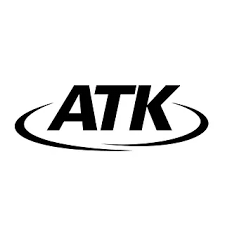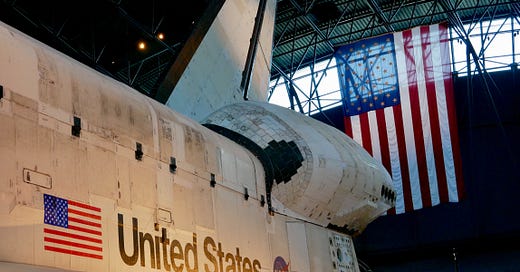The company that would be Morton
. . . and Thiokol . . . and Morton Thiokol . . . and Morton and Thiokol . . .

Once upon a time, in or around the year 1820, a salt extraction company was established in upstate New York. It was bankrolled by four men, of whom one was the famed whaler William Rotch Jr. of New Bedford.* This company was the Onondaga Salt Company near Syracuse, and it is a beginning point in a long and roundabout journey. That journey starts here, with wealthy men investing fortunes made elsewhere in salt, and it ends (at least in our telling of it) thousands of miles away with a salt company investing in space. And then contributing to a disaster. And then being spun off from the salt company. And then . . . contributing to a disaster.
But let's not get ahead of ourselves.
Onondaga Salt is named, of course, after the Onondaga people, one of the tribes of the Iroquois Confederacy. These were the original inheritors of the Great Lakes salt legacy. We will be hearing about them again, but, notably: not in this story. The corporate Onondaga Salt, meanwhile, was clear that it was seeking the cheapest extraction and farthest-ranging distribution possible. It is this urge that leads it west to Illinois, where in 1848 it establishes an office and a shipping and sales agent. That office is known as EI Wheeler, after its proprietor whose name shall be forgotten after this point, because in 1880 a man named Joy Morton buys into the company, eventually contributing a fleet of boats to move salt even farther and making an impressive amount of money in the process. (Distribution is always the name of the game with corporate-level extraction; remember that. We'll come back to it later in our series.) By 1910, the company is both selling and distributing salt as well as extracting it on its own--remember that the Great Lakes salt deposit flows underground all the way west to Gallatin County, Illinois--and it incorporates as Morton Salt.
And the story might end there. But . . . it doesn't.
There are, of course, innovations to be made. The tiny granules ("every one the same!") ground from solid rock. The anticaking agent allowing table salt to flow freely through a spout. The girl with the umbrella. The somewhat mystifying slogan ("When it rains, it pours!")
And there are companies to be bought.
While Joy Morton is expanding EI Wheeler's Illinois salt company, oil prospectors in Lyons, Kansas, drill for black gold . . . and strike white instead. Lyons Salt Company is organized, receives a cash infusion from St. Louis industrialist Alfred Bevis, goes bankrupt as a corporate concern, is bought at a sheriff's sale by none other than Bevis himself, and incorporates as Kansas-salt-2.0 under the name Bevis Salt. Stay with me here: Bevis. Salt.
Bevis Salt is bought, wholesale, by Morton in 1919.
So Morton goes on about its salty business, buying mines and dominating markets and extending into "solar saline" (read: desalinization) in the Bahamas. And then, in a move that leaves market analysts scratching their heads**, Morton acts swiftly in 1982 to purchase a company that appears to be well outside of its usual domain: the rocket propulsion company known as Thiokol.

The above image looks like a screen grab from an early Atari, but was apparently registered as a trademark in 1984 by Morton Thiokol. Its current federal trademark status is listed as: CONTINUED USE NOT FILED WITHIN GRACE PERIOD, UN-REVIVABLE. Let’s hope that’s accurate.
Thiokol made most of its money in government contracts. If your business is rocket propulsion, those government contracts meant NASA: Thiokol had been selected in 1973 as the corporate provider of rocket boosters to the U.S. space program. This partnership meant, in 1986, that Thiokol was instrumental in planning the much publicized launch of the Challenger shuttle, a voyage that included American teacher Christa McAuliffe. The shuttle, of course, was doomed, and the moment of its break up on its way into orbit defined a tragedy for a generation of kids, including me (I was a first grader that year, and that day was the first time I was aware of seeing an adult cry).

What appeared to be an explosion (and is still often and incorrectly referred to as such) was actually a fire in the right side booster rocket caused by a leakage of superheated gas, and it ultimately caused an in-flight break up of the shuttle. Leakage is generally not intended in any context, and in this one, a device had been created to stop it: a polymer O-ring, designed as part of the rocket assembly by our friends at Thiokol Corporation. Unfortunately, the O-ring failed, due both to fundamental design flaws and to unprecedentedly cold weather at the launch site, and Thiokol was named, though fault was never legally determined in the course of the subsequent settlement, as the responsible party. In a corporate sense, this meant that Morton Thiokol shouldered the blame, the parent salt company held liable in both settlement terms and in the court of public opinion for the sins of its adopted offspring.
In 1989, after protracted legal wrangling including civil suits from the families of several of the lost astronauts and under the specter of potential further liability, Morton Thiokol split roughly in half. Morton kept its salt business and related concerns, and Thiokol took the rocket company and established its corporate headquarters outside of Salt Lake City.
And that is the end of the story of how a salt company ends up co-authoring a disaster in space.
Except that again, it isn't: there are two further things to be said here, one an epilogue of sorts and the other a prologue.

The epilogue is this: Thiokol, of course, remains in the rocket business. It was purchased in 2001 by Alliant Techsystems, and its name officially changed to ATK, though it continues to be known in the field as Thiokol. Alliant Techsystems contracts with NASA to work on the space shuttle Columbia; like Challenger, the shuttle breaks up in flight, and the company formerly known as Thiokol finds itself once again at the center of an investigation.

Source: Robert Little, “Space Shuttle Loss Hurts Lookheed, Other NASA Stocks” (Baltimore Sun, Feb 4, 2003, link above)
The prologue is more complicated, and takes us back to the Bevis family in St. Louis, the owners of the company that in 1919 is bought out by Morton salt. Bevis Longstreth is the grandson of the original investor Bevis, and he is the president of the company that Morton buys. And then he takes his money from the Morton buyout and invests it. In chemistry. With a couple of British inventors who have accidentally discovered an insoluble (and terrible-smelling) resin while working in their laboratory, and who recognize the potential value of the compound but lack the capital to incorporate. And they already have a name for the product, taken from the Greek words for sulfur (theion) and glue (kolla): thiokol.
That's right. The beneficiary of the Morton salt buyout goes on to establish another company . . . called Thiokol. The companies appear, at least in the literature, to go their separate ways, but I found an archival note that acknowledged what the New York Times and Wall Street Journal's 1982 commentaries on the Morton-Thiokol merger did not: that in merging, Morton was seeking to save Thiokol from a hostile takeover bid. This is still an unusual level of concern to manifest merely for old times' sake; were the companies in fact connected the whole time, by blood or by money?
I didn't chase that lead, but I'd love to hear about it if you do.
Saltily yours until next week,
j
—-
*Shoutout to my Unitarian folks; the Rotch (pronounced 'Roach') family also bankrolled the construction of the New Bedford Unitarian Church. They weren't always Unitarians, however; the Rotch family had in fact been Quakers. As a wall placard at the New Bedford Whaling Museum notes on the subject: ostentatious wealth was frowned upon in the Quaker tradition. Thus, Captain Rotch became a Unitarian.
I'll leave you to your thoughts.
**The poor fools didn't have Wikipedia and digitized archives to immediately explain the family connections to them, though admittedly one feels that they might have asked one or two additional questions about this particular pairing. One must remember, however, that in the early 1980s the age of the corporate conglomerate was alive and well, and curating a selection of unlikely and unrelated bedfellows under a large corporate umbrella thus attracted comparatively little attention.



I worked at Morton Thiokol starting about 9 months before the Challenger.
My memories of the disaster are acute. We were at work. People would and running in the halls. And the shitshow that followed.
The o-rings didn't fail. Those boosters had a stellar record (compared to other boosters...). But they were launched outside of safe launch parameters, in fact outside of design parameters. They failed to do what they weren't designed to do. And it's a tale of pressure from above to say yes to things that should not have been said yes to, by execs and bean counters.
Pressure came all the way from the white house. Likely not Reagan personally, but someone close saying the president wants this launch. Make it happen.
It was a brutal lesson in how decisions get made—and why—by the wrong people, for the wrong reasons. And how the people responsible (at Morton Thiokol, at NASA, and at the White House) weren’t held accountable. But people who they abused and pressured and browbeat were. And people who weren’t even in the decision loop were, as well. In the wake of all that, they suggested that the booster construction workers needed drug testing (as a “benefit”).
(Someday, democracy of some sort will come to our workplaces—and things will be far from perfect, still. But it will be far better.)
I spent months of my work life thereafter documenting the o-ring/joint redesign for Congress. Hundreds of others did the design work. We spent vast amounts upgrading — making heavier and theoretically more effective — the o-ring joints. Which made the rockets heavier, which meant less payload could be sent to orbit. To ‘improve’ a joint that only failed when it was tested by launching under conditions that it was never designed to function in. And which the new joint would never be launched in, because of the past. It was... the Maginot Line; glorious on paper, designed for the past that would not be repeated, immensely costly, and... useless.
But it helped maintain a smokescreen or accountability.